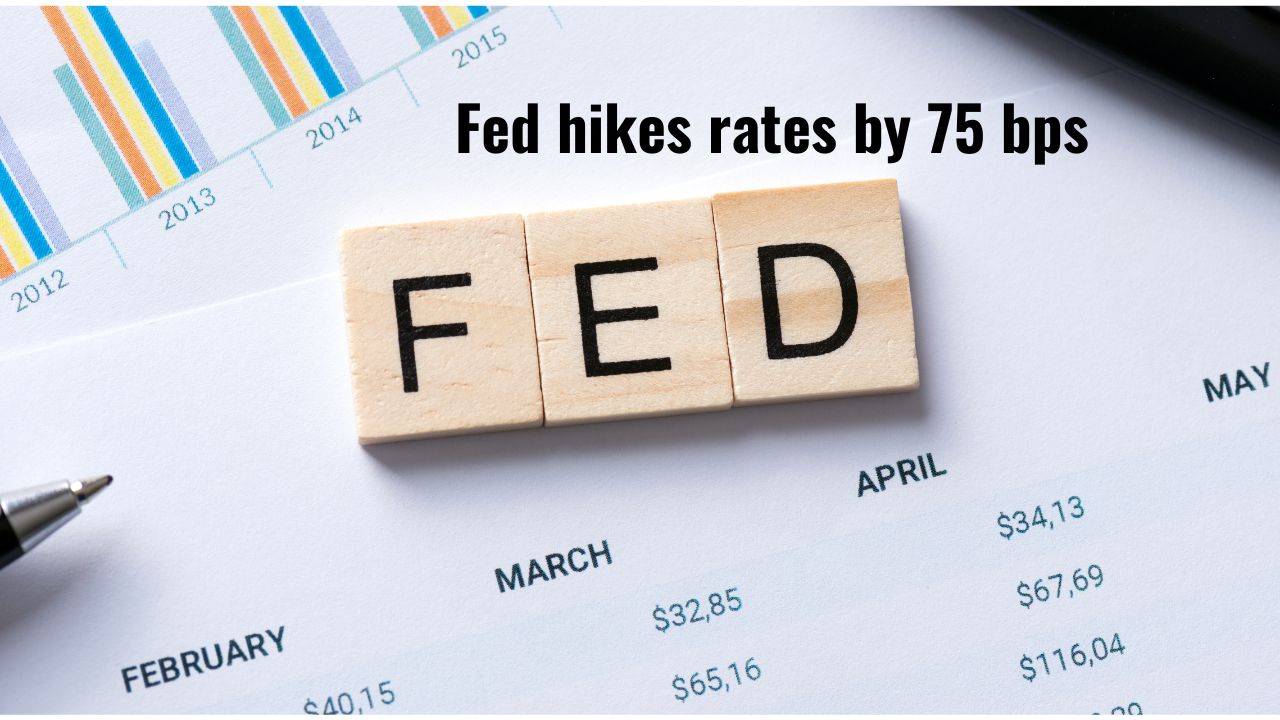Fed shocks the street with 75 bps rate hike

Last Updated: 17th June 2022 - 04:44 pm
The big question ahead of the Fed meet was whether the rate hike would be 50 bps or 75 bps. There really was no other question. Finally, the Fed decided to err on the side of hawkishness and opted to hike the rates by 75 basis points. It has now raised the rates by 25 bps in March, 50 bps in May and now by 75 bps in June 2022; taking the rate hikes since March 2022 to a total of 150 bps. The interest rates have gone up in this period from the range of 0.00%-0.25% to the current range of 1.50%-1.75%.
In addition, there is likely to be more front ending of rates. Till May, the idea was to reach 3% interest rates by December 2022, now it is 3.5% by December 2022. The target interest rates have also gone up from 3.5% to 4.25% by 2023. After all, the Fed had few options after the consumer inflation in the US came in at a 40-year high of 8.6%. The real for the Fed is double-digit food inflation, since it hits the most vulnerable sections of the economy.
What we read from the CME Fedwatch?
The CME Fedwatch is the best gauge of the future direction of interest rates as it factors in the probabilities from the Fed Futures market and is considered the most efficient. Here is what the CME Fedwatch says.
• The target for the rates by the end of December 2022 has now gone up to the range of 3.40%-3.50% and the Fed is likely to cross 4% by mid-2023.
• There are 4 more meetings to go in 2022 and another 175 bps to cover, so there could be 75 bps hike in July and a gradual tapering after that.
• The CME Fedwatch is suggesting that the Fed would like to front end the rate hikes to the extent possible so that they have time to review stance in 2023.
Of course, let us assume that the US economy dips into recession, then the entire narrative could change but that is something we have to wait and watch.
Start Investing in 5 mins*
Get Benefits worth 5100* | Rs. 20 Flat Per Order | 0% Brokerage
Fed says, inflation control at any cost
Remember that the 75 bps rate is happening for the first time in 28 years. It last happened in the year 1994, so clearly it is a special measure for a special situation. The Fed is also conscious about the implications. Here are some of thoughts expressed in the FOMC statement issued by Jerome Powell at the end of the FOMC meeting.
a) Fed estimates that due to these hawkish policy measures, inflation would fall to 4.3% by December 2022, 2.7% by end of 2023 and to 2.3% by the end of 2024. The long term median inflation target for the US economy stays at 2%.
b) The Fed is still keen to amplify the impact of rate hikes. So it will combine rate hikes with bond unwinding to the tune of $47.5 billion in June 2022. This will be scaled up gradually.
c) The measures will have an impact on jobs. For instance, the hawkishness of the Fed is likely to push the unemployment levels from 3.5% to 3.7% by December 2022. In addition, GDP growth is likely to fall in 2022 from 2.8% to 1.7%.
d) The Fed has made a pragmatic cut in growth outlook due to monetary tightening. The consensus indicates that while recession will be avoided, GDP growth would taper to 1.7% in 2022, against the prior forecast of 2.8%.
As Larry Summers and other economists have warned, the risk of this tightness translating into a recession is still there and cannot be wished away. A recession would be too big a price to pay for inflation control. Till that is evident, hawkishness will be the road ahead.
Does India have to be concerned with so much hawkishness?
Not exactly. If you look at the 3 factors that really matter to the RBI, India is comfortable on 2 factors and there is only worry on one factors. Here is the gist.
a) The primary challenge is to ensure that real rates in India are attractive compared to the US. With US inflation higher than in India, that may not be a real worry at this point.
b) Secondly, liquidity from passive investors could be impacted by bond book unwinding. However, $28 billion has flowed out of India since October 2021 and with the rupee also weaker at over 78/$, that may not be a big issue.
c) Lastly, a recession needs to be avoided and that could still be an open issue. For now, there is not much clarity on that front.
Interestingly, markets reacted positively to the FOMC action. Dow rallied 1% and NASDAQ rallied 2.5%. Even 10 year bond yields fell sharply from 3.47% to 3.31%. The Dollar Index (DXY) tapered from 105.70 levels to 104.87 levels. But if you look at the reaction in India, there appears to be a lot of panic in the markets. But that is a different story altogether!
Trending on 5paisa
05
 5paisa Research Team
5paisa Research Team
Discover more of what matters to you.
Disclaimer: Investment in securities market are subject to market risks, read all the related documents carefully before investing. For detailed disclaimer please Click here.

